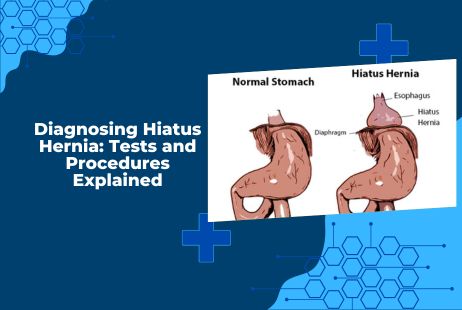
Diagnosing Hiatus Hernia: Tests and Procedures Explained
The diagnosis of hiatus hernia involves a series of necessary tests and procedures. Healthcare professionals employ these methods to ensure accurate identification and effective treatment.
Read on as we shed light on the significance of early diagnosis and explore the various techniques used in the diagnosis of hiatus hernia.
What is Hiatus Hernia?
When a portion of the stomach pushes through the diaphragm and into the chest cavity, it is known as a hiatus hernia or hiatal hernia. A muscle that sets the chest apart from the abdomen and aids in breathing is the diaphragm. The oesophagus can pass through an opening on it known as the hiatus.
There are two types of hiatus hernia: sliding and paraesophageal.
In a sliding hiatal hernia, which is more common, the junction between the stomach and oesophagus slides up into the chest when you swallow or eat. This can cause symptoms such as heartburn, regurgitation, and difficulty swallowing.
On the other hand, in a paraesophageal hiatal hernia, a part of your stomach pushes up through the hiatus beside your oesophagus and stays there. This type of hernia can be more serious as it may lead to complications like strangulation or obstruction of blood flow to part of your stomach.
The exact cause of hiatus hernias is unclear, but factors such as age, obesity, smoking, pregnancy, and certain medical conditions can increase your risk. It’s important to note that while some people with hiatus hernias may experience no symptoms, others may have discomfort ranging from mild to severe.
Symptoms of Hiatus Hernia
Hiatus hernia is characterized by the stomach protruding through the diaphragm into the chest cavity.
Common symptoms include:
- Heartburn or acid reflux: Stomach acid flows back into the oesophagus, this brings about a burning sensation in the chest and throat.
- Regurgitation of food or sour liquid.
- Difficulty swallowing.
- A feeling of a lump in the throat.
- Chest pain: Some individuals may have chest pain similar to heart attack symptoms, which can radiate to the neck, arm, or jaw.
- Respiratory issues: Hiatus hernias can lead to respiratory problems like chronic coughing, wheezing, and shortness of breath due to pressure on the diaphragm affecting lung function.
Note: These symptoms are not exclusive to hiatus hernia and can also be caused by other conditions. If you experience persistent or concerning symptoms, seek medical attention for an accurate diagnosis of hiatus hernia and appropriate treatment.
Diagnosis of hiatus hernia
Diagnosing hiatus hernia involves various tests and procedures to accurately identify the condition and determine the most suitable treatment options. Some common diagnostic methods are used:
- Upper Gastrointestinal (GI) Series or Barium Swallow:
- The patient drinks a barium liquid, which coats the oesophagus and stomach lining.
- X-rays are taken to visualize abnormalities or irregularities in these areas.
- Endoscopy:
- A slender, flexible tube with a camera appended is inserted through the mouth into the oesophagus and stomach.
- The camera allows direct examination, and tissue samples may be analysed.
- Additional Imaging Tests:
- Magnetic Resonance Imaging (MRI) or Computed Tomography (CT) scans may be ordered for more detailed information about the hernia’s size and position.
Dr. Girish Juneja is a professional who can precisely diagnose hiatus hernia and consider the patient’s unique circumstances.
Early diagnosis of hiatus hernia through these procedures leads to better outcomes and allows healthcare professionals to develop the optimal treatment plans for each patient.
Treatment Options for Hiatus Hernia
When treating hiatus hernia, several options are available depending on the severity of the condition and individual needs. It’s important to note that treatment focuses on managing symptoms rather than curing the hernia. Here are the key treatment approaches:
- Lifestyle Changes:
- Avoid trigger foods: Certain foods like spicy or fatty foods, alcohol, and caffeine can worsen symptoms. Limiting or avoiding these can help.
- Eating habits: Opt for smaller, more frequent meals to reduce pressure on the stomach.
- Maintain a healthy weight: Excess weight can exacerbate symptoms, so maintaining a healthy weight is beneficial.
- Medications:
- Proton pump inhibitors (PPIs): These medications help reduce acid production in the stomach, alleviating symptoms like heartburn.
- Antacids: Provide rapid relief by neutralizing the stomach acids.
- Surgical Intervention:
- Surgery may be necessary for severe cases to repair or reinforce the weakened area of the diaphragm.
- Open surgery or laparoscopy: Minimally invasive techniques are available for certain cases.
- Exercise and Postural Modifications:
- Certain exercises can help alleviate discomfort caused by a hiatus hernia.
- Postural changes may be recommended to reduce pressure on the stomach.
It’s essential to consult a healthcare professional specializing in gastrointestinal disorders for an accurate diagnosis and personalized treatment plan. They will consider your overall health, severity of symptoms, and medical history to determine the most suitable treatment options.
Consult Dr. Girish Juneja for an accurate diagnosis of hiatus hernia
With extensive experience in gastroenterology and a deep understanding of gastrointestinal disorders, Dr. Girish Juneja is a highly qualified medical professional you can trust.
His dedication to patient care and advancements in the field ensures you receive the best possible care for your condition.
Take the first step towards an accurate diagnosis of hiatus hernia resulting in prompt treatment.
Here’s a quick link to book an appointment with Dr. Girish Juneja!
